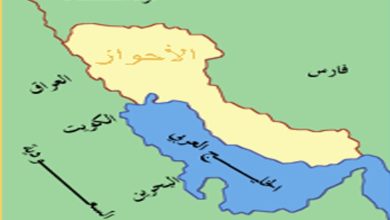
The destruction of Ahwazi heritage: The Ziggurat temple is threatened with collapse
The Arab civilization in Ahwaz and its ancient history are part of the hostility inherited by the Persians against this civilization, hoping to change the identity of the Ahwazis and end the Arab Ahwaz’s relationship with the Arab peoples. The neglect of the Ziggurat temple in the city of Susa in the occupied Arab state of Ahwaz, which was listed as a World Heritage site in 1979, poses a risk to the history of Ahwaz’s most prominent landmarks and the Elamite civilization.
The Ziggurat temple was built by the Elamite king “Untash-Napirisha,” one of the kings of the Semitic Elamite civilization that was established in 2700 BC, with its capital in the city of Susa.
On the walls of the Ziggurat temple, there are cuneiform bricks, all bearing the same text expressing the name of the king and his purpose for building the temple. The Ziggurat temple was a place for worshiping the Elamite gods and is the largest Ziggurat temple in the world outside of Mesopotamia.
The difference between the Ziggurats in Susa and those in Mesopotamia is that the upper layers of the Ziggurats were built on the lower floor. In Susa, the Ziggurats are characterized by having separate foundations for all layers, all built on the ground floor. The Susa Ziggurat represents the beliefs, culture, and traditions of one of the oldest civilizations in the region.
Although the Ziggurat temple is considered one of the most prominent ancient landmarks and specifically dates back to the Semitic Arab Elamite civilization, it does not receive sufficient attention. Despite being registered as a heritage site, it suffers from a lack of maintenance and is exposed to desecration by visitors roaming its courtyards and squares.
According to sources, this archaeological building and the surrounding area are continuously damaged due to unprofessional search and excavation operations carried out by entities affiliated with the Iranian occupation institutions, in addition to the neglect of building maintenance and protection from weather elements. Sources indicate that one of the main reasons behind the neglect is that these monuments are not linked to the Persian civilization but belong to the Elamite civilization, which is evidence of the existence of a thriving Semitic civilization in Ahwaz.
Attempts to erase Arab historical landmarks are part of the Persianization policy pursued by the Iranian occupying state against the Arab and civilizational heritage in Ahwaz. Ahwazi activists have warned of the deteriorating conditions in this building and called for heritage and archaeological protection institutions, including UNESCO, to intervene to save it and prevent this crime.




